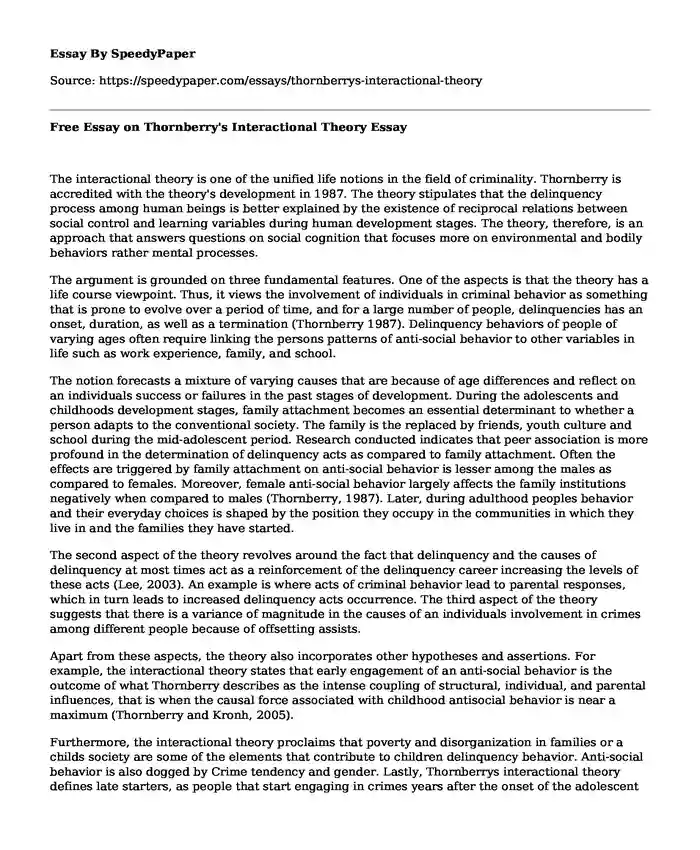
| Type of paper: | Essay |
| Categories: | Law Social psychology |
| Pages: | 3 |
| Wordcount: | 612 words |
The interactional theory is one of the unified life notions in the field of criminality. Thornberry is accredited with the theory's development in 1987. The theory stipulates that the delinquency process among human beings is better explained by the existence of reciprocal relations between social control and learning variables during human development stages. The theory, therefore, is an approach that answers questions on social cognition that focuses more on environmental and bodily behaviors rather mental processes.
The argument is grounded on three fundamental features. One of the aspects is that the theory has a life course viewpoint. Thus, it views the involvement of individuals in criminal behavior as something that is prone to evolve over a period of time, and for a large number of people, delinquencies has an onset, duration, as well as a termination (Thornberry 1987). Delinquency behaviors of people of varying ages often require linking the persons patterns of anti-social behavior to other variables in life such as work experience, family, and school.
The notion forecasts a mixture of varying causes that are because of age differences and reflect on an individuals success or failures in the past stages of development. During the adolescents and childhoods development stages, family attachment becomes an essential determinant to whether a person adapts to the conventional society. The family is the replaced by friends, youth culture and school during the mid-adolescent period. Research conducted indicates that peer association is more profound in the determination of delinquency acts as compared to family attachment. Often the effects are triggered by family attachment on anti-social behavior is lesser among the males as compared to females. Moreover, female anti-social behavior largely affects the family institutions negatively when compared to males (Thornberry, 1987). Later, during adulthood peoples behavior and their everyday choices is shaped by the position they occupy in the communities in which they live in and the families they have started.
The second aspect of the theory revolves around the fact that delinquency and the causes of delinquency at most times act as a reinforcement of the delinquency career increasing the levels of these acts (Lee, 2003). An example is where acts of criminal behavior lead to parental responses, which in turn leads to increased delinquency acts occurrence. The third aspect of the theory suggests that there is a variance of magnitude in the causes of an individuals involvement in crimes among different people because of offsetting assists.
Apart from these aspects, the theory also incorporates other hypotheses and assertions. For example, the interactional theory states that early engagement of an anti-social behavior is the outcome of what Thornberry describes as the intense coupling of structural, individual, and parental influences, that is when the causal force associated with childhood antisocial behavior is near a maximum (Thornberry and Kronh, 2005).
Furthermore, the interactional theory proclaims that poverty and disorganization in families or a childs society are some of the elements that contribute to children delinquency behavior. Anti-social behavior is also dogged by Crime tendency and gender. Lastly, Thornberrys interactional theory defines late starters, as people that start engaging in crimes years after the onset of the adolescent development stages. Such individuals exhibit very low levels of academic competence and intelligence. Notably, such people in their earlier development stages had both a supportive family institutions and school environments. (Thornberry, 1987)
References
Thornberry, T. P. (1987). Toward an interactional theory of delinquency. Criminology, 25(4), 863891
Thornberry, Terence P., and Marvin D. Krohn. (2005). Applying interactional theory in the explanation of continuity and change in antisocial behavior. In Advances in Criminological Theory (Vol. 14, pp. 183210). New Brunswick, NJ: Transaction.
Lee, S. (2003). Testing Thornberry's interactional theory: the reciprocal relations. Retrieved from Lowa State Uivesity: http://lib.dr.iastate.edu/rtd/601
Cite this page
Free Essay on Thornberry's Interactional Theory. (2019, Sep 16). Retrieved from https://speedypaper.net/essays/thornberrys-interactional-theory
Request Removal
If you are the original author of this essay and no longer wish to have it published on the SpeedyPaper website, please click below to request its removal:
- Multicultural Context of Business Negotiation - Free Essay on Business Communications
- Effects of El Nino, Free Essay Example
- Diabetes Essay Example
- Roman Civilisation Essay Example
- Spiritual but Not Religious: Essay Sample
- Essay Sample on Fortinbras Character in Hamlet
- Paper Example - Bardach's Eightfold Path
Popular categories




